This profile has been superseded by the 2019 version, which is available here.
View the complete Australian forest profiles series.
Information for this profile is drawn from Australia's State of the Forests Report 2013.
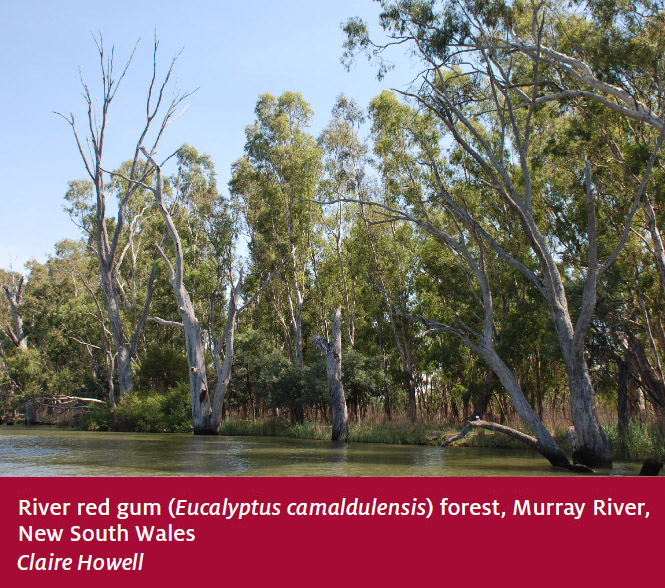 Eucalypts are iconic Australian forest trees. Ninety-two million hectares of the Eucalypt forest type occurs in Australia, and forms three-quarters of the total native forest area.
Eucalypts are iconic Australian forest trees. Ninety-two million hectares of the Eucalypt forest type occurs in Australia, and forms three-quarters of the total native forest area.
The term ‘eucalypt’ includes approximately 900 species in the three genera Eucalyptus, Corymbia and Angophora. Almost all eucalypt species are native to Australia. Eucalypts evolved from rainforest ancestors, adapting to an environment in which drought, nutrient-poor soils and fire were increasingly common.
Eucalypts have oil-rich foliage that burns readily, and they display a range of strategies to survive and recover from fire. The majority of eucalypt species are evergreen, retaining their leaves year-round.
Distribution and ownership
The Eucalypt forest type is found in all states and territories and across all but the continent’s driest regions (Map 1).
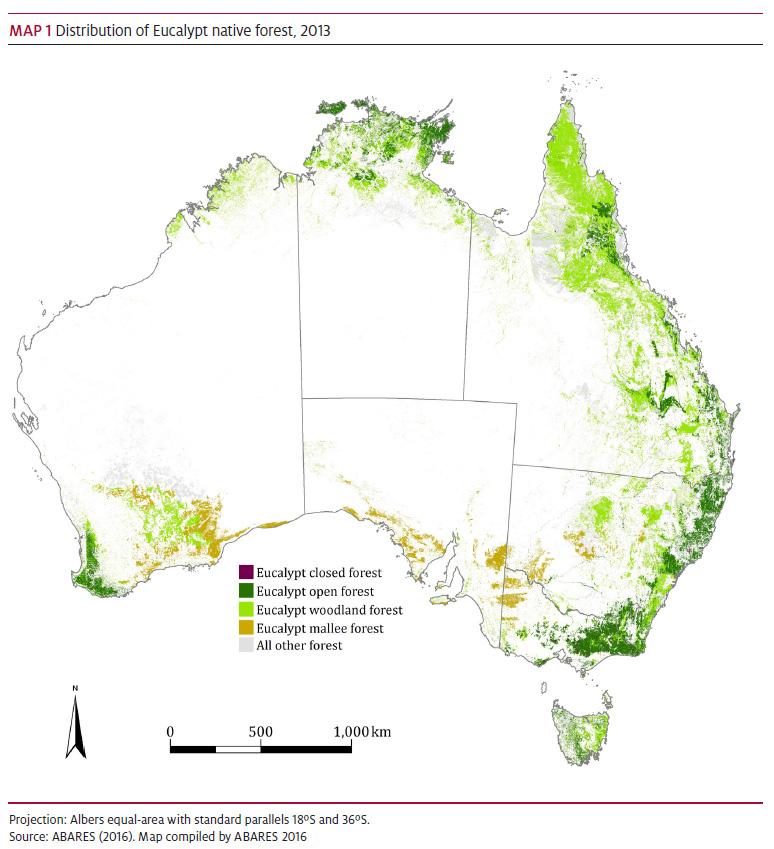
Open a high-resolution version of Map 1 that can be saved as a PNG file
A total of 35 million hectares (38 per cent) of the Eucalypt forest type is in Queensland and 16 million hectares (18 per cent) are in New South Wales. Thirty-three million hectares (36 per cent) are on leasehold land and 26 million hectares (27 per cent) are on private land (Table 1). Seventeen million hectares (18 per cent) are on nature conservation reserves.
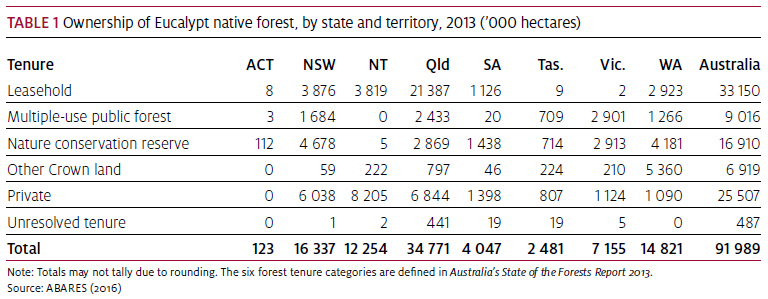
Download Table 1 data as an Excel workbook
River red gum (E. camaldulensis) is the most widely distributed eucalypt, and is found in all Australian mainland states. The forests of south-eastern Australia contain a wide range of dominant eucalypt species, including major commercial timber species such as mountain ash (E. regnans), messmate stringybark (E. obliqua), alpine ash (E. delegatensis), silvertop ash (E. sieberi), blackbutt (E. pilularis) and spotted gum (C. maculata).
Eucalypt forest in south-western Australia are dominated by jarrah (E. marginata) and karri (E. diversicolor). Typical eucalypts of northern Australia include Darwin woollybutt (E. miniata) and Darwin stringybark (E. tetrodonta).
Many species of multi-stemmed mallee eucalypts are found across the inland regions of southern Australia. In inland arid zones, eucalypts are confined to the edges of rivers. Eucalypts are generally not found in the tropical and subtropical rainforests in eastern Australia, or in the warm and cool temperate rainforests of Victoria and Tasmania.
Forest structure
The Eucalypt forest type is divided into 11 forest classes based on the form of individual trees, crown cover and tree height. Eucalypts grow in two forms: single-stemmed trees and multi-stemmed mallee.
Eucalypt native forest comprises 80 million hectares of non-mallee trees and 12 million hectares of multi-stemmed mallee (Tables 2 and 3).
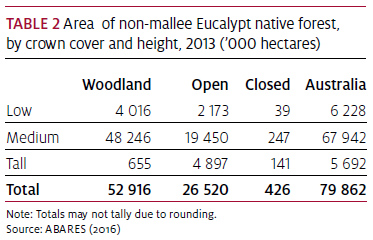
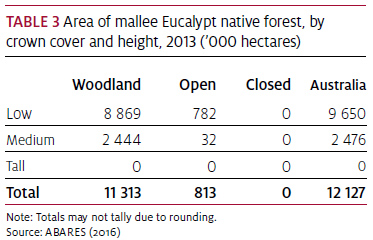
Sixty-six percent (53 million hectares) of non-mallee Eucalypt forest is woodland forest and 85 per cent (68 million hectares) is medium-height forest (Figure 1).
Mature mountain ash (E. regnans) trees are usually between 55 and 75 metres high and are an example of tall forest. Some mountain ash trees can grow to more than 90 metres, making this the tallest plant species in Australia, one of the tallest hardwoods, and one of the tallest flowering plants in the world.
Ninety-three per cent (11 million hectares) of mallee Eucalypt forest is woodland forest and 80 per cent (10 million hectares) is low forest (Figure 2).
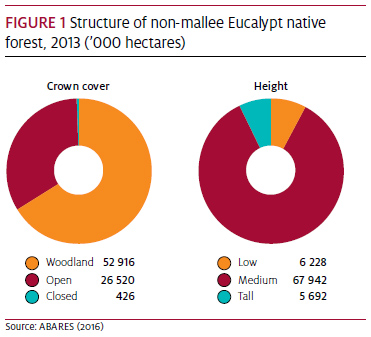
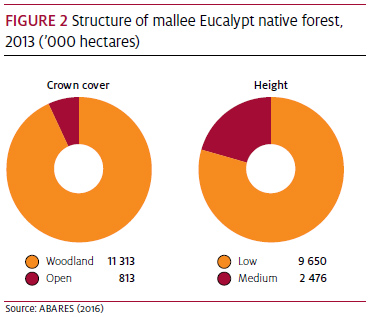 Download Figure 2 data as an Excel workbook
Download Figure 2 data as an Excel workbookImportance and uses
Eucalypt native forests are important for the conservation of Australia’s rich biodiversity. They support many forest-dwelling or forest-dependent species of flora and fauna. This includes species endemic to Australia and species that are listed as threatened under the Commonwealth Environment Protection and Biodiversity Conservation Act 1999.
Indigenous Australians have traditionally used nearly all parts of eucalypt trees. Leaves and leaf oils have medicinal properties, and saps can be used as adhesive resins. Bark and wood have been used for making vessels, tools and weapons such as spears and clubs.
Because of the size, wood quality and widespread distribution and abundance of eucalypts, eucalypts are a significant source of wood. The variability in wood colour, shape, hardness, weight, strength and durability makes eucalypt useful for many applications. Sawn wood is used in large-scale construction, general building, furniture-making and wood-turning. Engineered wood products such as laminated veneers, fibreboards and particleboards are used for construction and flooring. Eucalypt wood is also used for chipping, paper pulp and fuelwood. Oils distilled from eucalypt leaves are used for aromatherapy and in perfumes.
Bibliography
ABARES 2016, Forests of Australia (2013) v2.0, Australian Bureau of Agricultural and Resource Economics and Sciences.
Boland, D, Brooker, M, Chippendale, G, Hall, N, Hyland, B, Johnston, R, Kleinig, D, McDonald, M & Turner, J 2006, Forest trees of Australia, 5th edn, CSIRO Publishing, Melbourne.
Carnahan, JA 1990, Atlas of Australian resources, vol. 6, Vegetation, Australian Government Publishing Service, Canberra.
Montreal Process Implementation Group for Australia & National Forest Inventory Steering Committee 2013, Australia’s State of the Forests Report 2013, Australian Bureau of Agricultural and Resource Economics and Sciences, Canberra.
